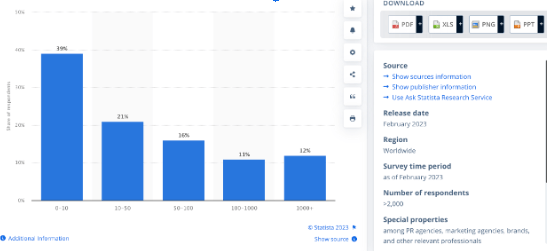Key highlights
- The influencer marketing industry is booming reaching $21 billion in 2023.
- Influencer analytics uses tools and data to match brands with the right influencers, optimize campaigns, and measure success.
- Influencer analytics removes subjectivity, letting brands compare options, refine content, negotiate fair deals, and maximize ROI.
Have you ever wondered what happened to traditional advertisements and celebrity endorsements while casually scrolling on Instagram? With 23% of brands worldwide focusing 40% or more of their marketing budget on influencer marketing, it’s safe to say there’s a new sheriff in town. What started with ‘mommy bloggers’ back in 2009, the influencer marketing industry has skyrocketed, reaching USD 21.1 billion in 2023. Even micro-influencers with smaller, more engaged followings are carving their own niche. Why? Consumers trust these individuals more than celebrities who are hard to relate to. In fact, studies prove it – influencer marketing drives positive returns for brands and influences consumer choices. No wonder millennials and Gen Zers are drawn to this lucrative avenue. However, with over 500,000 influencers on Instagram alone, more brands should be asking- which influencer is the best fit for my brand? Enter influencer analytics.

What is influencer analytics?
Influencer analytics comprise tools and techniques that are used to gather and analyze data on the performance of influencers and their impact on brand campaigns. This data is crucial for brands to make informed decisions about which influencers to partner with, how to structure campaigns, and how to measure success.
Key metrics and data points involved:
- Engagement rate: The percentage of followers who interact with an influencer’s content (likes, comments, shares).
- Audience demographics: Age, gender, location, interests, etc., of the influencer’s followers.
- Reach: The number of unique individuals who see the influencer’s content.
- Brand sentiment: How the influencer’s audience perceives the brand being promoted.
- Conversion rate: The percentage of followers who take a desired action (e.g., click a link, make a purchase) after interacting with the influencer’s content.
Data-driven decision making is pivotal for brands seeking optimal influencer partnerships. Essentially, influencer analytics allows you to:
- Compare and contrast potential influencers: By analyzing their key metrics, you can objectively assess which influencer aligns best with your brand persona and target audience.
- Optimize campaign content and messaging: Data from previous influencer collaborations can inform future content, tailoring it to resonate more effectively with the identified audience.
- Negotiate fair compensation: With clear data on an influencer’s reach and engagement, you can ensure fair pricing and budget allocation for your campaign.
- In essence, influencer analytics transforms the once subjective realm of influencer marketing into a measurable and strategic practice. By leveraging data, brands can maximize their return on investment and forge fruitful collaborations that truly influence consumer behavior.
The role of influencer analytics for brands: Beyond reach and likes
In essence, influencer analytics offers brands much more than just gauging audience reach and content likes. Here’s how it empowers impactful collaborations:
1. Enhancing campaign effectiveness with data insights
By analyzing previous campaign data, brands can identify which content formats generate the highest engagement, which platforms receive the most traction, and how different audiences respond to various messaging styles. Meaning, this data-driven approach allows you to refine your future campaigns for enhanced effectiveness and optimize your message for maximum impact.
2. Targeting the right audience with laser precision
Influencer analytics takes one step beyond calculating the number of followers and also delves into the demographics and interests that fuel those numbers. Ultimately, this granular data allows brands to target specific audience segments through carefully chosen influencers, ensuring your message resonates with the consumers most likely to convert. This way, influencer analytics lets you target specific segments that work for your brand.
3. Measuring ROI with meticulous accuracy
Influencer marketing can be incredibly valuable, but quantifying its return on investment (ROI) can be tricky. However, influencer analytics provides the tools to do just that. By tracking website traffic, conversions, and sales attributed to influencer campaigns, brands can measure the direct impact of their investment and assess whether their collaborations are driving actual revenue. This data-backed approach ensures that your influencer marketing efforts are not just generating likes and shares, but also contributing to your bottom line.
Key metrics to focus on in influencer analytics: Navigating data overload
It’s crucial to identify the key metrics that are covered by influencer analytics. Here are three essential metrics to focus on for optimal campaign performance.
1. Engagement rates and their significance
Engagement rate can be a powerful indicator of an influencer’s audience interest and receptiveness. In short, a high engagement rate, calculated as the total number of likes, comments, and shares divided by the follower count, suggests an active and engaged audience that interacts with the influencer’s content. This translates to potential for deeper brand engagement and higher conversion rates for your campaign.
But simply tracking the overall engagement rate isn’t enough. Instead, it’s important to dive deeper by analyzing:
- Type of engagement: Are users commenting, sharing, or just passively liking? A good mix indicates active participation and discussion.
- Sentiment analysis: Understand the tone of the engagement. Are comments positive, neutral, or negative? This provides valuable insights into audience perception of the brand.
- Engagement per platform: Different platforms have different engagement patterns. Analyze which platform yields the highest engagement for your chosen influencer and prioritize it for your campaign.
2. Audience demographics and behavior analysis
Knowing the age, gender, location, and interests of an influencer’s audience is crucial for targeting the right consumers. While reach tells you how many people might see your message, audience demographics pinpoint who those people are. This data allows you to align your target audience with the influencer’s: Is the influencer reaching the demographic you want to engage with? If not, consider alternative options.
Additionally, understanding audience demographics allows you to anticipate purchase decisions and predict campaign outcomes with greater accuracy.
Here are some things to consider:
- Content preferences: What types of content does the audience typically engage with? Videos, blog posts, or Instagram stories?
- Purchase behavior: Analyze past campaign data to see if the influencer’s audience converts into actual customers for similar brands.
- Brand affinity: Does the audience already have a positive perception of your brand or similar products?
By understanding the audience on a deeper level, you can ensure your message resonates with the right people. Ultimately, this drives conversion and purchase decisions.
3. Conversion tracking and its impact on sales
In conclusion, the goal of any influencer marketing campaign is to drive sales. Conversion tracking measures the effectiveness of your campaign by monitoring how many viewers of the influencer’s content actually visit your website and make a purchase. This metric reveals the true impact of your collaboration on your bottom line.
By tracking conversions, you can measure the ROI of your influencer marketing investment and evaluate the effectiveness of your chosen partnerships. Eventually, this data informs future campaign decisions, allowing you to prioritize influencers who demonstrably drive sales and contribute to your business goals.
Remember, influencer analytics is an ongoing process. Continuously monitor your chosen metrics, analyze the data, and adapt your strategy accordingly. By harnessing the power of these key metrics, you can navigate the complexities of influencer marketing and ensure your collaborations deliver tangible results for your brand.
Still wondering if your brand could benefit from investing in influencer analytics? Tap into our VoC-driven E-commerce Analytics services and find the right influencer marketing strategy for you. Reach out to us today.






